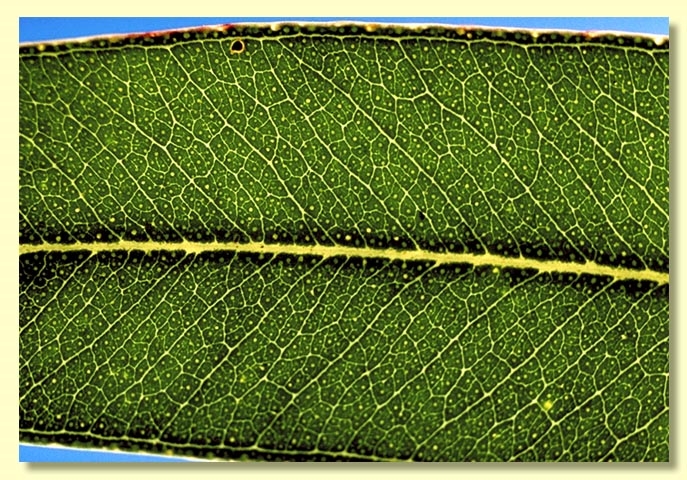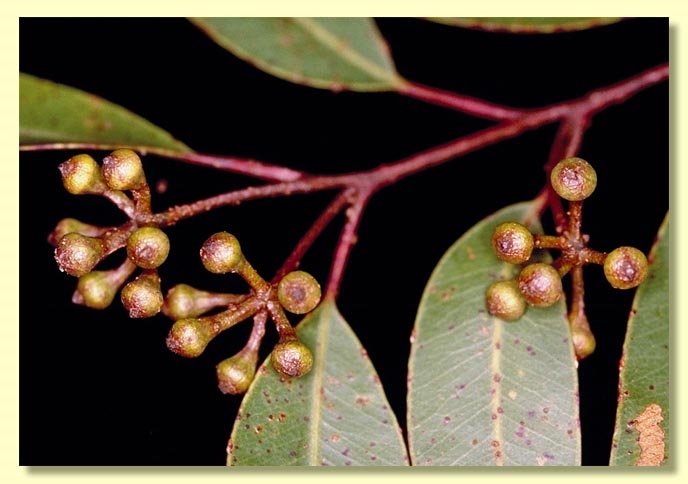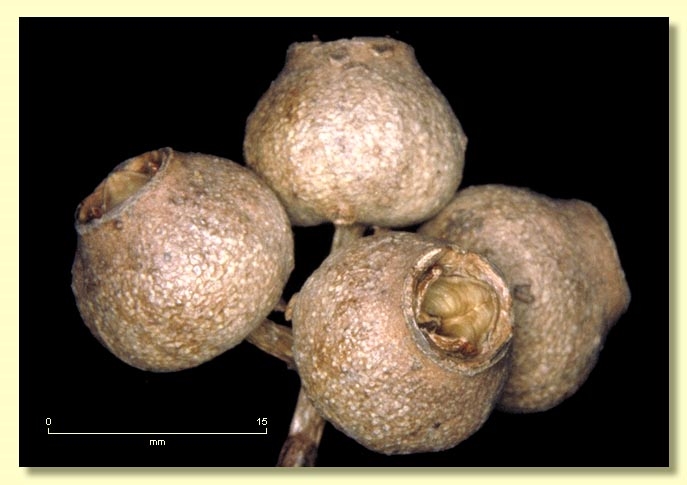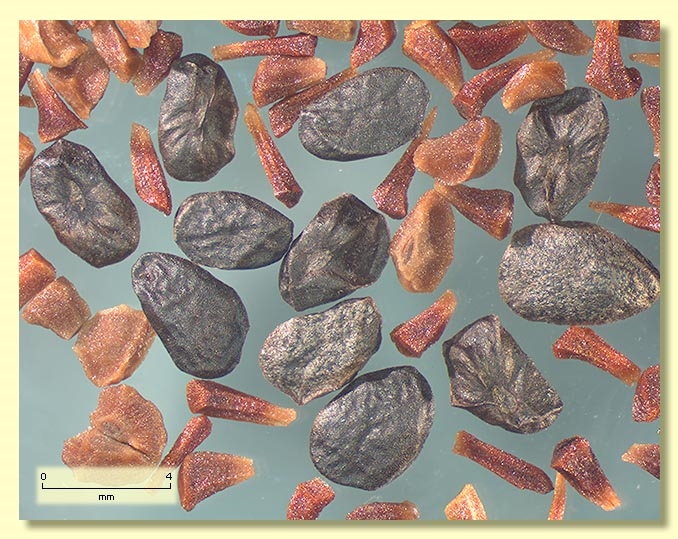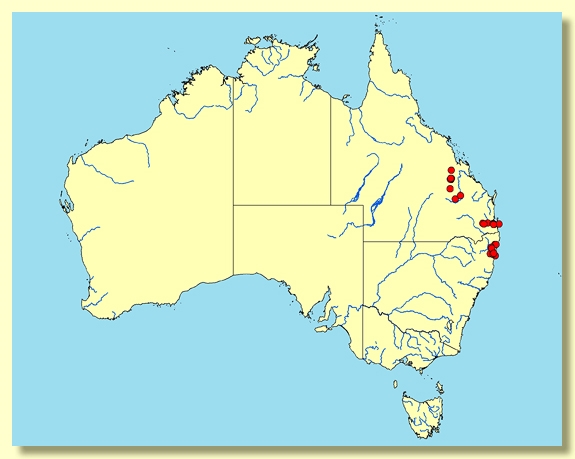Euclid - Online edition
Eucalyptus baileyana
Eucalyptus | Eudesmia | Reticulatae | Scuttelliformes
T: Qld: Coopers Plains, F.M.Bailey s.n ., June 1878; lectotype: MEL1606591; fide Bean, A.R., Telopea 12(4): 513 (2010).
Bark rough on trunk and larger branches, stringy or fibrous, grey to reddish-brown.
Branchlets with oil glands in the pith.
Juvenile growth (coppice or field seedlings to 50 cm): stem rounded in cross-section, scabrid with stellate hairs; juvenile leaves always petiolate, opposite for a few pairs, becoming alternate, lanceolate, 6–15 cm long, 2.5–7.5 cm wide, margin entire, discolorous, usually dark green, scabrid for many pairs; new growth tips conspicuously stellate-hairy and often bright pink.
Adult leaves alternate, petiole 1.2–2 cm long; blade lanceolate to falcate, 9–16.5 cm long, 1–2.5 cm wide, base oblique or tapering to petiole, discolorous, glossy or dull, dark green, side-veins greater than 45° to midrib, moderately to densely reticulate and fine, intramarginal vein parallel to and just within margin, oil glands mostly island.
Inflorescence axillary unbranched, peduncles 1.5–2.5 cm long, buds 7 per umbel, pedicels 0.3–0.9 cm long. Mature buds clavate to pyriform, 0.5–0.8 cm long, 0.3–0.5 cm wide, brown, or green, often with 2 longitudinal ribs, scar absent (minute sepals present and positioned on upper part of the hypanthium), operculum conical or rounded and "apiculate", stamens arranged in 4 groups, inflexed, anthers cuboid to oblong, versatile, dorsifixed, dehiscing by longitudinal slits (non-confluent), style short, locules 3, the placentae each with 4 vertical ovule rows. Flowers white.
Fruit pedicellate (pedicels 0.3–1.2 cm long), truncate-globose or urceolate, 0.9–1.5 cm long, 0.8–1.7 cm wide, sometimes ribbed longitudinally, rim with 4 small lobes (formed from the sepals), disc descending, valves 3, slightly exserted or near rim level.
Seeds dark grey to black, 3–5 mm long, flattened-ovoid to flattened, dorsal surface smooth or shallowly pitted, hilum ventral.
Cultivated seedlings (measured at ca node 10): cotyledons reniform; stems rounded in cross-section, stellate-hairy; leaves always petiolate, opposite for 2 or 3 nodes then alternate, usually ovate, sometimes lanceolate, 6–15 cm long, 3–7.5 cm wide, base lobed to rounded, strongly discolorous, dark green above, paler below, with stellate hairs on petiole, veins and margin.
Flowering has been recorded in January, April, October, November and December.
A small to medium-sized tree of northern coastal New South Wales from the Coast Range and Orara Valley into south-eastern Queensland, usually on sandstone. It is distinguished by the rich red-brown fibrous bark with black occlusions, densely hairy juvenile leaves, discolorous adult leaves, buds in sevens, stamens clustered in four distinct groups around the staminophore, and the almost globular fruit with four shallow "teeth" on the rim and three valves.
It is not closely related to nor does it resemble any other species in eastern Australia. Seeds are thick, flattish, blackish and weakly lacunose.
Eucalyptus baileyana belongs in Eucalyptus subgenus Eudesmia because of the combination of cotyledons reniform in shape and folded and clasping in embryo, juvenile leaves with stellate hairs, buds with the calyx lobes fused near the apex, stamens arranged in four bundles and the presence of oil glands in the pith of the branchlets. Within subgenus Eudesmia, E. baileyana is in the section Reticulatae, series Scuttelliformes and is the only representative in this series, which is distinctive because of its stringy bark, white flowers with a short style, seeds without a marginal flange, and eastern distribution. E. baileyana is closest to E. similis, another Queensland species belonging to the subgenus Eudesmia. E. similis can be distinguished by its yellowish bark, smaller cylindrical to barrel-shaped fruit, 0.6–1 cm wide and buds with a long style. (E. baileyana has larger truncate-globose to urceolate fruit, 1–1.7 cm wide and buds with a short style.)



